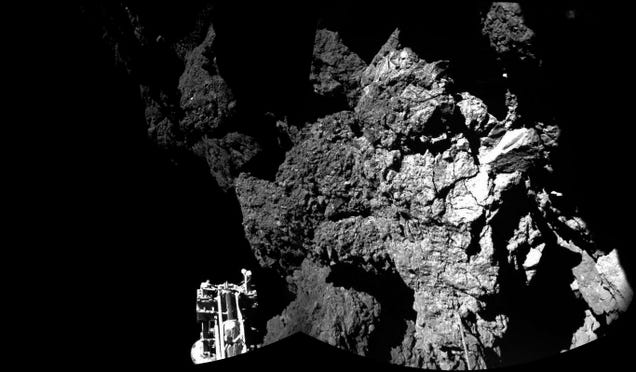Pretty Cool...
Posted: Thu Nov 13, 2014 1:13 pm
http://www.cnn.com/2014/11/13/world/com ... ?hpt=hp_t2Space probe makes bouncy landing on comet
(CNN) -- This week's historic space probe landing on a comet 310 million miles from Earth wasn't exactly a poetic ballet, but it still worked.
Anchoring harpoons that were supposed to deploy when the Philae probe made impact didn't, lander manager Stephane Ulamec said Thursday.
The lander also came with screws to burrow into the surface. They didn't work either.
It made for a bouncy landing. Ulamec said Philae bounced three times before coming to a stop.
Not pretty, but still the lander came to rest on solid ground. A success anyway you look at it.
European Space Agency scientists and executives high-fived and hugged one another when the landing was confirmed on Wednesday. Spacecraft have crashed into comets before, but this was the first soft, or controlled landing, in history.
'A place in the history books'
"Our ambitious Rosetta mission has secured a place in the history books: not only is it the first to rendezvous with and orbit a comet, but it is now also the first to deliver a lander to a comet's surface," Jean-Jacques Dordain, ESA's director general, said in a statement.
Many people, and not just the ones who work for ESA, are excited about what kind of information Philae will deliver.
"Rosetta is trying to answer the very big questions about the history of our solar system," said Matt Taylor, ESA Rosetta project scientist. "What were the conditions like at its infancy and how did it evolve? What role did comets play in this evolution? How do comets work?"
And science fiction writer Alastair Reynolds said: "This is science fiction made real in terms of the achievement of the mission itself, but Rosetta is also taking us a step closer to answering science fiction's grandest question of all: Are we alone?"
Rosetta took off from Earth 10 years ago carrying Philae and traveled 6.4 billion miles before arriving in early August at the comet.
The Philae lander separated from the orbiting Rosetta around 3:30 a.m. ET Wednesday and landed on the comet seven hours later.
ESA lander system engineer Laurence O'Rourke told CNN that the orbiter Rosetta had to be in the right position to allow the lander craft, which had no thrusters, to "free fall" on the correct trajectory so it landed on the comet.
The lander weighs about 220 pounds and is the size of a domestic washing machine. The target comet is only four kilometers, or 2.5 miles, in diameter.
Named after Rosetta Stone
Shortly after landing was confirmed, the probe tweeted: "Touchdown! My new address: 67P!" Later, it tweeted again: "I'm on the surface but my harpoons did not fire."
What can we learn from comet landing?
The mission has historic allusions.
The spaceship is named after the Rosetta Stone, an inscribed piece of volcanic rock found in Egypt in 1799 that allowed scientists to decipher hieroglyphics and thus understand the ancient Egyptian culture, ESA said. The lander is named after an island in the Nile River where an obelisk was found that helped decipher the Rosetta Stone, ESA said.
Led by ESA with a consortium of partners including NASA, scientists on the Rosetta comet-chasing mission hope to learn more about the composition of comets and how they interact with the solar wind: high energy particles blasted into space by the sun.
The comet is currently 500 million kilometers (310 million miles) from Earth and pictures from the Rosetta mission to track it on its orbit around the sun have amazed scientists.

